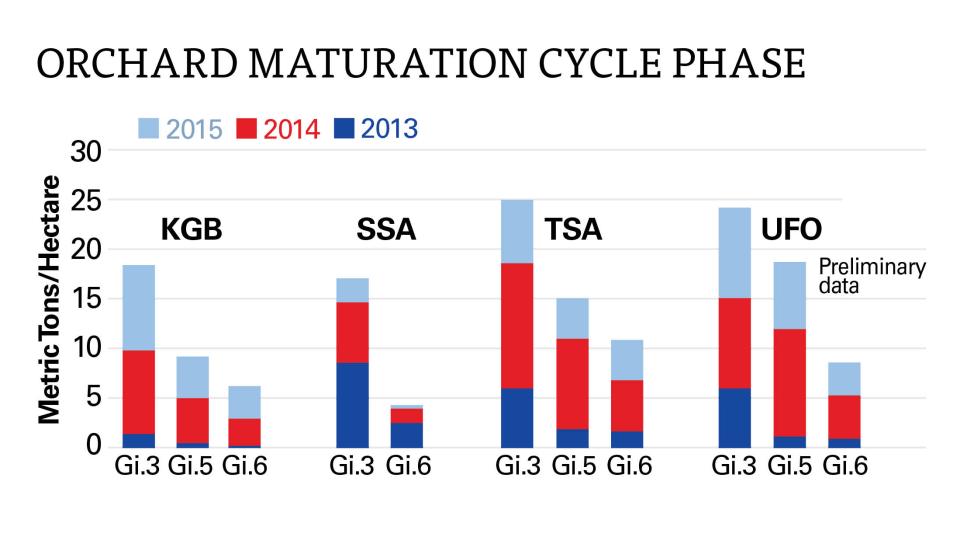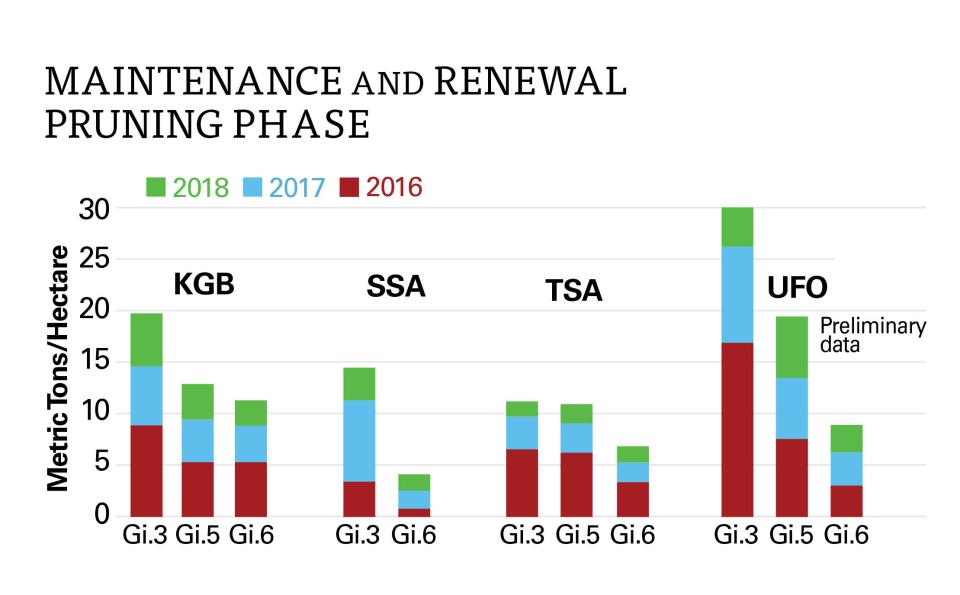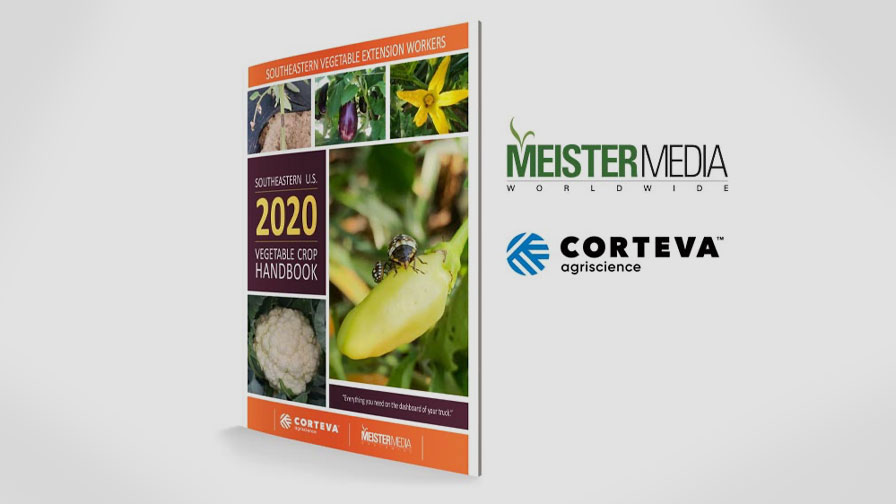Deciphering Yield Data and Renewal Pruning for Cherries
My column last fall highlighted the importance of renewal (vs. maintenance) pruning as being particularly important in high-density sweet cherry orchards for sustainable production of premium-quality fruit as the orchard ages. The column detailed how this renewal pruning is accomplished in the different training systems of the NC-140 Regional Research trial and the challenge of renewal on highly productive trees, especially when using vigor-limiting rootstocks. Let’s examine how annual tree yields can vary, as the structural development of young orchards is completed and they enter the maintenance and renewal phase.
A preliminary examination of relative annual yield data from the NC-140 trial at Clarksville, MI, allows comparison of the first three years of production as the trees finished filling their allotted orchard space (2013-2015) with the next three years as the mature canopies were maintained and renewed (2016-2018).
With orchard maturation, yields increased for Kym Green bush (KGB) trees on Gi.5 and Gi.6 and upright fruiting offshoots (UFO) trees on Gi.3 (see bar graphs). Yields remained similar for KGB trees on Gi.3, super slender axe (SSA) trees on Gi.6, and UFO trees on Gi.5 and Gi.6. Yields decreased for SSA trees on Gi.3 and tall spindle axe (TSA) trees on all rootstocks.
Does this mean we’re ready to declare “winners” and “losers” yet? Not exactly. Although the caveats of this being one trial, with one cultivar, in one location, must always be considered with any experiment, let’s also consider the results thus far with the knowledge that management, such as how they are pruned for renewal, of each training system and rootstock combination may not yet have been optimized.
 Comparing the Data
Comparing the Data
For the KGB trees, comparing the two three-year periods of yield data suggests that the trees on Gi.3 may have reached their maximum yield potential early and were able to maintain it, while the trees on Gi.5 and Gi.6 were still maturing, and increasing in yield, during the maintenance and renewal timeframe.
For the SSA trees on Gi.6, yields varied little over time but, as these yields were extremely low, this is likely an indication that such a high-density system is inappropriate with a semi-vigorous rootstock in a vigorous growing site like Clarksville. The SSA trees on Gi.3, however, exhibited higher yields during the earlier time frame, indicating that perhaps their renewal has not been optimized since the early yield potential has not been sustained.
The SSA is the only training system in the trial in which 100% of the tree is renewed every year, through extreme pruning of every shoot. Also, over time, some older fruiting branches must be renewed back close to the leader (to remove excessively blind wood), especially higher in the tree, to prevent shading and excessive upper canopy vigor. The relatively high yield in 2017 suggests that yield recovery is possible with optimized pruning, and the 2018 yield decline may have been due more to spring frost, since the reduction occurred essentially across all training systems.
 A Look Over Time
A Look Over Time
For the TSA trees, the decline in yields over time on all of the rootstocks suggests several possibilities, including 1) that renewal to create new fruiting wood has yet not been optimized, and/or 2) shading has become an increasing problem, resulting in the loss of fruiting wood. Visual evaluation of these trees’ dormant structure suggests that it is a combination of both factors. Poor renewal shoot growth itself may be a combination of competition with developing fruit and lower light levels in the canopy interior where the renewal shoots must arise.
For the UFO trees, the consistency in yields over time for the trees on Gi.5 suggest that their maximum yield potential was achieved fairly early and has been maintained year in and year out. This also may be the case with the trees on Gi3, with the higher overall yield in the latter period due to a very high 2016 yield. Conversely, if the 2016 yields represent the maximum potential for UFO/Gi.3, then refinement of renewal and maintenance pruning strategies for this combination also must be examined further to determine whether such yields can be sustained.
The consistent, yet lower, yields for the UFO trees on Gi.6 may imply that the trial tree spacing was too close, resulting in excessive vigor at the expense of fruitfulness. Wider spacing, with the development of more upright fruiting offshoots, would likely reduce the vigor and increase the flower bud formation on each individual fruiting offshoot. This spacing caveat may also pertain somewhat to the TSA/Gi.6 trees, though shade is also clearly a factor in such a three-dimensional canopy compared to the planar UFO.
Variable Impact Results
Consequently, these data comparisons are still considered preliminary, as they have not yet been tortured with statistics to reveal potentially hidden interactions. They are arbitrary, three-year snapshots subject to a total of six different years of climatic variables like spring frost, ever-changing daily temperatures, wind, rain, sunshine, and cloudiness during pollination, fruit set, fruit development, and ripening. Similarly, there are inherent weaknesses in interpolating yield data comparisons in trials where, by experimental design necessity, the tree spacing may not be optimized for every training system and rootstock vigor combination.
Since such relative examinations can be made between years and between training systems, they provide significant guidance on refining annual pruning and renewal strategies. Although this trial was scheduled to be complete after 10 years (2019), these results suggest that data collection should perhaps be extended an additional few years to see whether renewal pruning modifications might further optimize each system’s sustainable yield potential. The next column will explore one particularly radical strategy.










